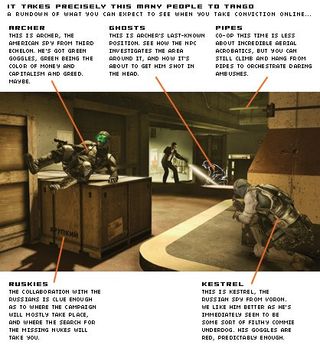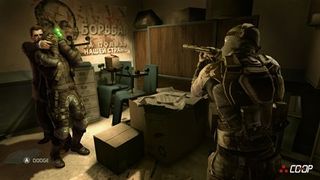Yastreb ends with me lugging Major Rebko to an eye and fingerprint scanner with my teammate providing cover. Gunmen stream onto the mezzanine outside Rebko’s office, while Redding monkeys along balconies, popping up above the railing to grab enemies and throw them down to the floor below. Then there’s a twist, tables are turned dramatically and we find ourselves in the most Mexican of stand-offs. We fade to black. The playthrough is over. Just 20 minutes of a five-hour co-operative campaign, outside of the Fisher-focused single-player adventure. The question is: who would ever want to play single-player after that?

But this is (very almost) 2010. Multiplayer without a World at War-style Siege mode, or a Left 4 Dead-style Survival mode, would cause ladies to faint in the street, and men to start brawling and tumbling through shop windows. With this in mind, on top of a co-op campaign fledged to within an inch of its life, you’ll find, astonishingly, Deniable Ops, a collection of maps playable in four different game types with either one or two players. It’s also designed to be played over and over until our sun explodes, with Ubisoft reckoning that Deniable Ops is where players will clock up most of their playtime.
A quick and humorless rundown of the four game types then. Hunter has you eliminating all enemies on a map as quickly as possible. Infiltration has you doing the same, but forces you to avoid detection. Last Stand is Conviction’s nod to an increasingly popular game mode in which you must defeat increasingly well-equipped waves of enemies. And finally, Face-Off pits two spies against one another in a map populated by AI guards.
I’m shown the Lumber Mill map in Infiltration mode, this time in single-player. The crippling loneliness is made worse by the sense that you’re now half as effective as you were before, and with that comes the burden of having to mark your own enemies and scout your own routes – it’s a remarkably different experience. Lumber Mill is notable for all of its piles of lumber, great big trunks stacked in well-lit rows, forcing you to make daring scoots down between bright wooden corridors and clamber among the rusted machinery.

Unlike the story-led co-op mode, in which enemies’ starting positions are dictated by level designers, Deniable Ops promises “emergent gameplay”. That is, enemies will crop up in different places each time you play. This creates some interesting situations in the Face-Off games, especially when combined with one of the single-player game’s features: last known position.
Successfully breaking line-of-sight with the AI leaves behind a ghostly visage of yourself, indicating where the AI last copped eyes on you. The AI will investigate that area, or simply fire blindly at it while you maneuver yourself to a more advantageous location. In Face-Off, using your last known position to lure guards towards your opponent is also a viable tactic.
Of course, in this mode the game-ending executions are impossible to pull-off against human players. It’s also, you might have noticed, the only non-co-operative part of Conviction’s multiplayer game. Spies vs Mercs won’t appear in Conviction, as Ubisoft focus their efforts on the lengthy co-op campaign.
Tying the whole experience together is P.E.C.S. (the Persistent Elite Creation System): XP that’s earned with everything you do in single and multiplayer. Challenges are set across both single- and multiplayer, requiring you to kill certain numbers of people with certain weapons, or achieve other unlikely feats. With the XP you earn from doing so, you’ll be able to get upgrades, new equipment, and costumes for Archer and Kestrel.

Clearly, Conviction’s multiplayer won’t be a side feature. For many it’ll be the main attraction, a juggernaut of a co-op campaign bolstered by the inclusion of replayable Deniable Ops missions. Splinter Cell seems to have found a new online niche, shedding the Spies vs Mercs (sure to cause some pained howls at first) in favor of the richer co-op experience. From what we’ve seen thus far, the change in focus is paying off.
Dec 21, 2009

